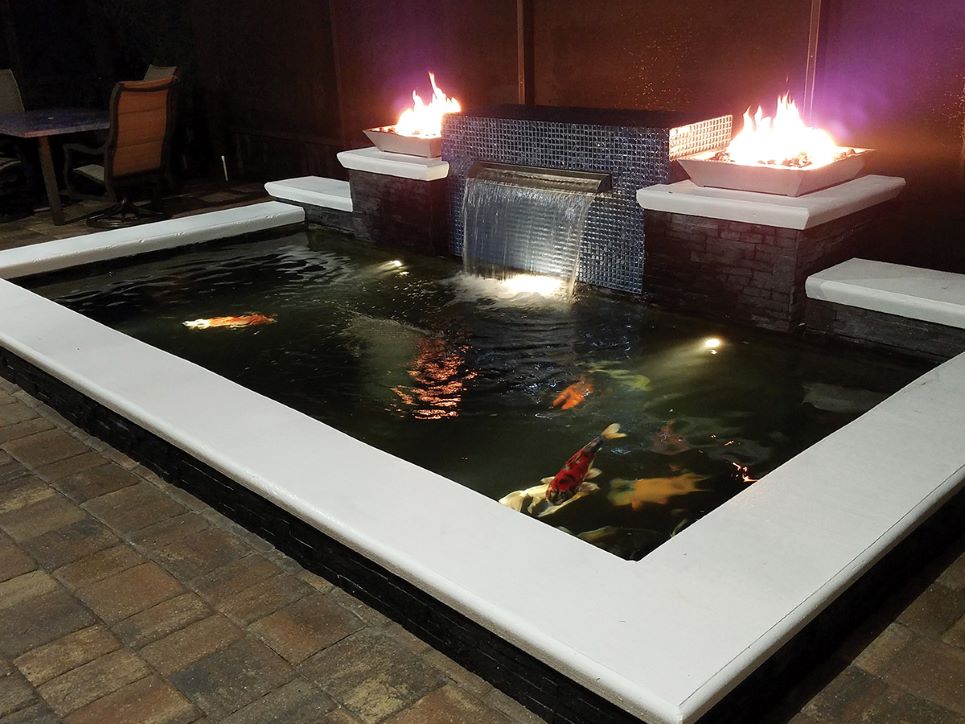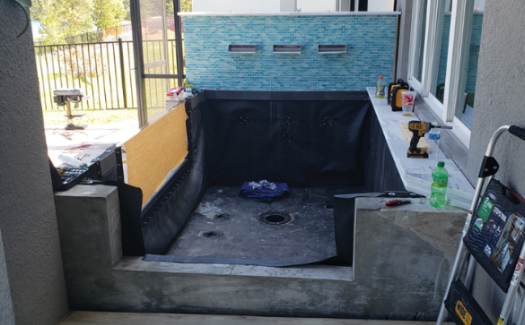
As I wrote this article, I found myself using the term “traditional” to describe koi ponds with clean lines and more of a geometric design than those natural koi ponds seen in beautiful Japanese Zen gardens. This made me pause to consider my choice of words.
As Steve Urkel would say, “Did I do that?” From where or whom did I pick up this term? How did I conclude what signifies “traditional?” I have no idea, but I have since replaced “traditional” with “formal” in this article. This best describes the type of pond design I’m referring to, without infringing on koi pond history, tradition, etc. (I’m trying to be Switzerland here, people!)
‘Formal’ Education

These past few years, I have noticed an increase in the demand for formal koi ponds. More and more clients are asking for geometric-designed ponds with cleaner lines and more refined finishes. Many want a pond design that better matches the home’s design, whereas in past years, clients tended to lean toward tropical getaway backyard water features.
“I have come to understand that deciding to have a formal koi pond is a very personal decision our clients make, and they need to be involved more so in the aesthetic design than with natural-looking ponds with rock waterfalls.”
Freddie Combas – FWG Designs
To meet this demand, we broke down the various materials and equipment that could be used, along with the construction methodology, in a manner that could accommodate different budget requirements. We figured that our construction options for the structural portion of the koi pond could be wood, concrete block or gunite. Since we are in Florida, we decided that with all the rain and moisture, wood ponds weren’t for us. Instead, we would focus on using either concrete block or gunite. Gunite is a mixture of cement, water and sand that is pressurized and shot through a hose at high pressure to produce a very dense, hard shell.
Small vs. Large Ponds
Once we crunched the numbers, we decided to build smaller ponds from concrete block and liner, and all larger ponds from gunite.

Small ponds would be excavated, and a footer would be formed and reinforced with steel rebar before pouring concrete. The footer would be drilled and rebar epoxied to extend vertically at a distance of every other concrete block cell. The mechanical skimmers, plumbing for skimmers, water feature returns, mid-level drains, jets, conduits for underwater lights, etc., would be installed at this time before the concrete block.
Depending on the pond wall height, rebar would run horizontally through all the concrete block cells to tie them all together, and all blocks would be filled with concrete. Underlayment and liner would be placed inside the pond, attached and sealed to bottom drains, skimmers and jets, and anchored to the top of the pond walls. A tile band is then installed to allow for easy cleaning of the crud that will form at the waterline and is nearly impossible to clean off the liner. The liner and the tile band anchoring system on top of the pond walls would then be covered once the decorative coping is installed.
Larger ponds, on the other hand, are excavated, with all plumbing (bottom drains, skimmers, jets, lighting, etc.) installed and a steel rebar cage built and prepared to the gunite applied to create the pond shell.
Once the shell has cured, we apply a sealer to make the pond watertight. There are different sealer types and colors that the client can choose from. We always recommend black, since the beneficial bacteria will grow on the interior pond walls and turn them a dark color anyway.
Formal Pond Design Considerations

So, when a client says they’re interested in a typical 11-by-16-foot, 2-feet-deep rock and gravel koi pond with a waterfall filter and liner, many of us know exactly to the penny what our cost, time to build and profit will be without asking any questions other than, “Will your deposit be cash, check or credit card?” Once the boulders are delivered, off you go to express your artistic abilities .
Am I right, or what? When you design a formal koi pond, there are a lot of decisions that the client has to make. Is the pond shape going to be round, square, rectangular, trapezoidal, etc.? Is the pond going to be built below grade, above grade, or half below grade and half above grade? Will the exterior wall finish going to be stucco, tile, stone, etc? Is the water being returned to the pond via a decorative overflowing bowl, one weir, two weirs, or three weirs off an elevated wall? Is that elevated wall going to be stucco, tile, stone, etc? If tile, which tile? If stone, which stone? Are the weirs stainless-steel or copper, round, square or rectangular?
I can honestly tell you that I have fully renovated two bathrooms in my house that I took down to the subfloor and studs, and I didn’t have to make as many design decisions as my clients have to make when we are designing a formal koi pond. Deciding to have a formal koi pond is a very personal decision our clients make, and they need to be more involved more in the aesthetic design than with natural-looking ponds with rock waterfalls.
I am well aware that clients look to me to create a natural-looking pond with a waterfall and stream, and I will gladly take on the role of designer and builder, selecting each boulder and placing them as I see fit and wherever I want. With a formal koi pond, these aesthetic decisions need to be made by the client. It is my job to listen to what they are saying and guide them in the materials-selection process to achieve their aesthetic goal. At the same time, when they want white tiles at the waterline or any other request that would be a maintenance nightmare, I step in and guide them to a better decision without destroying their overall vision.
Formal Filtration
So by now your client thinks you are about done designing their formal koi pond but au contraire mon frère! Now is the time to go over the filtration system design and equipment to distinguish yourself from the competition that doesn’t offer formal koi-pond installations. Go ahead, don’t be shy. Show your knowledge on external filtration systems and use some big boy and big girl multisyllabic words like ultraviolet sterilization, Nitrobacter, Nitrosomonas …
I jest, but seriously, explain the need for external filtration and pumps. Make sure they understand how bottom drains collect waste, how aeration systems create the proper dissolved-oxygen levels throughout the entire water column, how UV lights aid in eradicating parasites, etc. There’s absolutely nothing wrong if you only install waterfall filter-type ponds. However, you are leaving a huge chunk of change on the table, so I suggest that you “get learned!”
Higher Value

All this considered, it is clear that one cannot take the easy cookie-cutter approach to build a formal koi pond. I feel that this is one of the reasons many pond builders stay away from building them. If you are currently approaching the building of ponds in a manner that keeps things simple, I suggest you look into the profits that can be generated by expanding your construction knowledge and abilities. More time and effort go into the design and build of a formal koi pond, so you should get paid more. There are fewer pond builders out there who build formal koi ponds, so you can charge more — it’s a supply and demand kind of thing.
Then, there is the higher perceived value of a formal koi pond over the same-sized pond with naturally inspired aesthetics. I can tell you that in terms of materials, equipment and labor, a deep rock and gravel pond will cost you about half of what is required with a formal pond. However, you can charge up to three times or more for a 11-by-16-foot, 4-foot-deep formal koi pond, depending on which building materials, aesthetic finishes and construction methodologies you choose.
The real opportunity for additional profits is in the details, and the more complex or different you make a design, the more profit you can generate. While you can charge more for using bigger boulders in a pond with natural aesthetics a factor of $X, you can charge $3X for installing a viewing window or a fire feature to a formal pond. There’s another $3X! The design and finishes possibilities are endless!
Expand your formal koi pond business

I’ll put it like this. There are two fishermen fishing off the shore. One has one fishing pole, and the other has two fishing poles. Which would you rather be?
Obviously, I don’t want to be either of them — I want to be the captain of the boat with the large seine net! We are living in very uncertain economic times, so you might want to consider expanding your current offerings to clients. Challenge yourself and your crew. Change with the times or get left behind. No formality here; just keeping it real.


